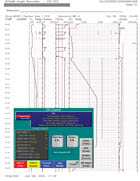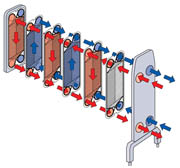Along with an accounting of the procedures and ingredients that go into a batch, FDA and other regulatory agencies are asking for documented proof that production equipment is clean and free of bacteria before producers begin to make the next product. The clean-in-place (CIP) system, which sanitizes the manufacturing equipment for the next production run, can provide this vital information electronically. And, when working in concert with the plant-wide batch control system, a CIP system looks like just another phase in the process.
When CIP becomes an integral part of the batch process, manufacturers are able to fine tune the system to run more efficiently, use fewer chemicals, consume less water, and provide a bacteria-free platform to start the next batch.
Regulations push CIP
Existing government regulations-and new ones on the way-are driving home the importance of CIP. For example, FDA's Hazard Analysis and Critical Control Points (HACCP) were developed more than 30 years ago to provide guidelines to keep food safe for astronauts. Today, HACCP is just one of the driving forces behind CIP. Another is FDA's 21 CFR Part 11 rules for electronic signatures and record keeping, which has been applied to several batch software products and has helped to make tracking and tracing of product and ingredients much easier. According to Tim Johnson, engineering manager at Avid Solutions, a systems integrator specializing in food and beverages, customers want to be certain that cleaning cycles and metrics are traceable with accurate records of CIP operations as well as records of the process itself. In addition, they want tie-ins to supervisory-level systems and hope to take advantage of the newer instrumentation that can help them prove CIP efficacy.
"Tighter CIP process control is being applied to control, monitor and report the critical cleaning parameters of time, temperature, chemical concentration and physical action," says John R. Miller, president, Seiberling Associates Inc. "Additional instrumentation is being implemented to monitor chemical solution conductivity to provide for improved flow control. The trend towards electronic record keeping is enhancing this quality effort, providing detailed historical performance data over the old circular chart recorders."

New regs
According to Gabe Miller, lean leader at Ecolab, two recent regulations could ultimately have an impact on food processors and equipment manufacturers. First, the Pasteurized Milk Ordinance (PMO) has accepted electronic documentation of CIP cycles, thus allowing CIP data to be monitored and stored for easier cycle verification, and for retrieval in the event of a sanitation-related problem. Second, the 3-A Sanitary Standards Organization has implemented a program for third-party verification of 3-A authorizations. This has improved the acceptance of 3-A authorization by federal and state inspectors, reducing the burden on a processor to "prove" that equipment is sanitary. At the same time, the scope of the 3-A standards is being expanded to include all food processing equipment.While some manufacturers will comply with FDA validation because they have to, others will have more compelling business reasons and use electronic methods to save time. Jim Brown, Wonderware's vice president of global OEM sales, suggests a few good reasons for validation. First, food producers are increasingly aware of the legal ramifications of bad or spoiled product causing illness or death. And it's a fact that just one incident of bad food causing sickness can kill a brand name overnight. In addition, large corporate customers like Wal-Mart are not only auditing their suppliers' facilities, but also demanding conformity and validation.
Special software demands
Cognizant of the benefits of CIP software applications, customers of Omni Integrated Solutions prefer integrated systems over standalone CIP systems. Company President Rich Birks notes that in the last two to three years, customers who installed new process control systems have asked to integrate the CIP system with the control system. Most of his customers are implementing control systems with data storage to disk and Ethernet communications, which allows CIP data to be brought into a HMI. With CIP data in the HMI, plants can manage the costs of cleaning chemicals and water usage more effectively.
There are benefits to integrating CIP with batch systems. Industry Manager, Process Control Systems/Batch, Siemens Energy and Automation, Ed Montgomery, notes that as more plants implement the S88 batch products, they definitely see a strong advantage in integrating the CIP system with the main process control system. Once the CIP process is integrated into the main process control system, the chance that a CIP cycle can be missed becomes almost non-existent. Also, documenting that a CIP was conducted can be handled in the same way as documenting the main process control system, thereby eliminating the need for specialized training on the CIP system.
According to Lorenzo Majewski, industry application lead for food at Rockwell Automation, batch management software easily incorporates CIP functions. By extending batch management to include CIP, users get CIP-related data reporting, such as what circuits were cleaned, what temperatures were used, what pressures were applied, how long chemicals and temperatures were held at critical points, and what operators initiated the process. Batch systems easily hold temperatures and pressures automatically, and if there are alarms, they appear in the same format as process alarms, with which operators are already familiar. Majewski says that until all the data is moved into the batch system, operators can still hold onto their signed chart recorder output as legal documentation.
Conserving resources and chemicals
Clean water is not cheap. According to Jean Pierre Caron, manager of performance production projects, Wonderware ArchestrA Application and Alliances Group, CIP can consume more water than necessary if it isn't well planned. In addition to needing clean water to run CIP operations, producers have found that they just can't throw dirty water back in the river-they have to clean it up before it goes down the drain-and cleaning it costs money. Pat Cauller, VP strategic accounts, Johnson Diversey, says that the environmental impact almost requires a producer to employ reuse systems because wastewater treatment costs are going up and the cost of chemicals has cycled around to where it makes sense to reuse them whenever possible. Years ago, there seemed to be an unending supply of clean water, and chemicals weren't that expensive. Today, according to Rockwell's Majewski, producers save and reuse whatever they can. For example, in a cheese operation, the water that is separated from the whey is clean enough that it can be used for pre-rinses in the CIP cycle.
According to Cauller, most CIP operations will do a rinse, followed by a caustic wash, and finally a sanitizer to kill bacteria. The sanitizer used is often peroxyacetic acid (similar to hydrogen peroxide) or a chlorine/iodine solution. The brewing and soft-drink industries typically use acidic cleaning in many operations (often nitrates and phosphates), but there are now many environmental restrictions on nitrates and phosphates. One environmentally friendly solution is to replace the nitric and phosphoric acids with Glycolic acid, which has minimal ecological impact, and is effective in CIP operations as a sanitizer. Biodegradable, Glycolic acid is both alcohol and acetic acid, and has low toxicity.

Another issue is the consideration of chemical/water reuse and two levels of contamination. One level is merely the potential contamination of a CIP process with live organisms in a used solution. Second, and potentially more dangerous, is the possibility of spreading allergens from one process to another through common cleaning systems and fluids. The two key allergen problems are with peanuts and shellfish, either of which can prove fatal to people who are highly allergic to these foods. According to Cauller, chlorine (sodium hypochlorite) used in the CIP cycle will break down and render these allergens risk-free.
Equipment and components
According to Miller, one of the biggest challenges still remaining is the need for the design and fabrication of processing equipment to be "CIPable." "If food processors would specify in advance that the process equipment they purchase and install is CIPable," says Miller, "the equipment processors will design and fabricate the equipment accordingly." While the equipment's initial cost is higher, the reduced cleaning time with improved cleaning performance can pay back the initial investment very quickly. Further, the repeatability of the CIP process provides greater assurance that the equipment will be properly cleaned on a daily basis.
Having a machine be CIPable means that its components must be able to withstand CIP. In packaging machines and other production equipment, the use of pneumatics could be problematic because of the inability of pneumatics-based components to survive the washdown environment. Kjell Lyngstad, industry manager, food & packaging at Bosch Rexroth, notes that IP ratings for pneumatic devices rarely were better than IP20. His company has been working to toughen up these devices, and has come up with a family of valves and cylinders that can withstand washdown pressures to 1450 psi and are corrosion resistant. This means that the valves no longer have to be mounted in a SS cabinet, but can be located closer to the actuators.
Other advances in components, such as CIP heaters, can improve the overall operating efficiencies of CIP. In one dairy plant, a shell-and-tube heat exchanger failed on a fairly frequent basis. It was replaced with a Pick SC25-1 sanitary heater prior to the system pump to provide fast heat-up of the CIP solution. Since the original installation, three other SC25-1 heaters have replaced failing shell-and-tube units. Don Bohner of Tetra Pak Inc., suggests that plate heat exchangers are a viable solution. Some of the newer devices eliminate many of the problems caused by using traditional plate systems such as steam velocity noise and erosion, over surfacing of traditional plate designs to keep water pressure drops low, and reduced gasket life with traditional plate gaskets.
Sometimes CIP is not the final step in a production process. Jon Barber of Spraying Systems Company recounts the story of one food manufacturer that had detected mold on the outside of glass bottles of one of its product lines. Thought to be at first a CIP problem, the cause of the mold turned out to be dried, excess product trapped under the bottle label. Various spraying pressures, spray angles, and nozzle types were evaluated. The final solution included using multiple nozzle types in multiple positions, and spraying from different directions to ensure thorough bottle cleaning with adequate impact to remove excess product.
CIP systems, while a key part of any process, usually require a completely different approach to process control than the batch you use to make your product. While it may be easy to program a new recipe for a batch, getting the CIP process right before beginning the process should not be based on guesswork.
For more information:
Jon Barber, Spraying Systems,
630-665-5201,
www.spray.com
Jim Brown, Wonderware,
949-727-3200,
www.wonderware.com
Tim Johnson, Avid Solutions,
336-771-0010,
www.avidsolutionsinc.com
John R. Miller, Seiberling Associates,
614-764-2817,
www.sieberling.com
Gabe Miller, EcoLab,
651-293-2438,
www.ecolab.com
Rich Birks, Omni Integrated Solutions,
419-782-0818,
www.omni-intsolutions.com
Daren Moffatt, Invensys,
daren.moffatt@ips.invensys.com
Ed Montgomery, Siemens,
314-872-2802,
ed.montgomery@siemens.com
Lorenzo Majewski, Rockwell Automation,
414.382.3198,
lpmajewski@ra.rockwell.com
Ingmar Pahlsson, FMC FoodTech,
+011 4642 490 4353,
ingmar.pahlsson@intl.fmcti.com
Dave Pearson, Starfrost,
+44 (0)1502 562206,
www.starfrost.co.uk
Don Bohner, Tetra Pak Inc.,
847-955-6332
Jean Pierre Caron, Wonderware,
949-727-3200
Kjell Lyngstad, Bosch Rexroth,
859-281-3484,
kjell.lyngstad@boschrextroth-us.com
Pat Cauller, JohnsonDiversey,
843-342-6800,
pat.cauller@johnsondiversey.com
